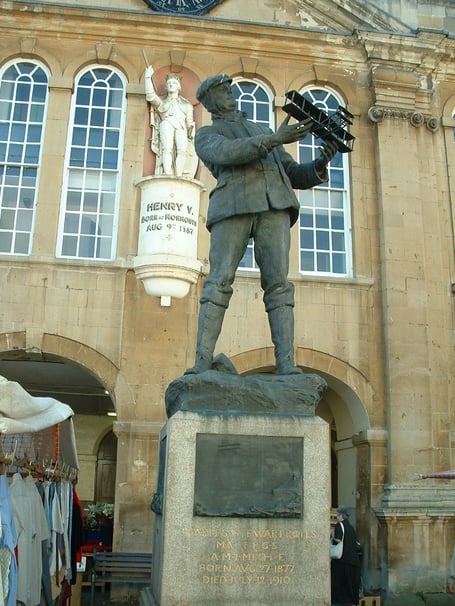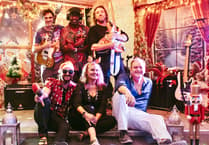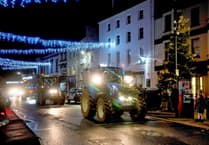Charles Stuart Rolls
TO my mind the finest statue in Monmouthshire is undoubtedly the one depicting Charles Stuart Rolls (1877 -1910) which stands in front of Shire Hall in Agincourt Square, Monmouth. It was sculpted by Sir William Goscombe John who was commissioned to commemorate Charles Rolls’ achievement for becoming the first person to fly non-stop both ways across the English Channel, but by the time the statue was erected he had been killed in a flying accident. It thus became a memorial to the first Briton to die in a plane crash.
On August 27th, 1877, Charles Rolls was born in Berkeley Square London, the youngest child of John Rolls Ist Baron Llangattock and Georgina Rolls Baroness Llangattock. Their ancestral home was The Hendre, a Grade II Listed building 4 miles north west of Monmouth. Originally it was built in the late 17th century, but the present large building dates from the middle of the 19th century. It came into the Rolls family by marriage in 1767.
John Rolls was a very wealthy man, rich enough to maintain a large country mansion, a large London house and among other things an impressive ocean-going yacht. His estate extended to 1,000 acres complete with a deer park containing 1,000 deer and surrounded by a tall iron fence. In 2003 it was described as ‘the grandest and most important Victorian park and garden in Monmouthshire.
With the death of the 2nd Lord Llangattock at the Somme, the title became extinct and the family connection with The Hendre ended in 1980. The house then became the centre for the 18 hole Rolls of Monmouth Golf Club with function rooms available for weddings and conferences.
Charles Rolls from an early age showed a practical interest in things mechanical and went up to Cambridge in 1895, where he gained a B.A. in Mechanics, Applied Science and later an MA degree. While there he took up cycling, racing for his university and gaining a half-blue in the sport.
Charles was tall and rather thin, and his eyes stood out from their sockets rather more than usual. He liked to wear a Norfolk jacket and a very stiff white high collar and while motoring he would turn his cap back to front.
It was in 1894 that Rolls while on holiday in Paris saw his first car, and two years later he had his first ride in one, a Peugeot owned by Sir David Salomans, one of the earliest British motoring pioneers. Then at the age of 18, Charles travelled back to Paris to buy a Peugeot Phaeton and became one of the first car owners in Wales. He drove the car from London to Cambridge University at an average speed of just over 4mph, and took 12 hours to complete the journey. The following year he drove a far quicker Panhard et Levasson from Cambridge to The Hendre, Monmouth, taking 2 ½ days. When he passed through Monmouth it was the first car ever to be seen in the town and was witnessed by people who had been expecting him for two days.
When the Duke and Duchess of York, the future King George V and Queen Mary, visited The Hendre, staying for a week, Charles took them for drives through the Wye Valley, visiting Tintern Abbey and the surrounding countryside.
Five years later, with the financial support of his father, he opened the first car dealership in Britain. It was known as C.S. Rolls & Co and was situated in Fulham. The firm flourished and he was soon opening showrooms in the West End of London.
He established a world land speed record of 93mph in Dublin, driving a 30hp Morris and In 1906 he formed a partnership with Frederick Henry Royce to be known as Rolls Royce Ltd. They were to produce the most sought after cars in the world. Also in that year Charles won the RAC Tourist Trophy race on the Isle of Man, driving a 20hp Rolls Royce at an average speed of 39.43mph for the 161 miles.
Charles became a keen balloonist, and by special arrangement, used to fill his balloons with gas from the Monmouth gasworks at a cost of £10 a time. He made more than 170 ascents altogether, and in a balloon race from Paris, he crossed the Channel to England, and landed in Norfolk, having been in the air for 26 hours.
His ballooning exploits led to the formation of the Aero Club, which later became the Royal Aero Club in 1910 and was responsible for the training of military pilots in its early days.
It was in 1903 that the Wright brothers made the first flight in a power driven heavier than air machine and Charles soon went over to France to meet them, and his flight with Wilbur Wright convinced him that this was what he must do next.
In 1909 he bought a ‘Wright Flyer’ from them and made over 200 flights in it. One year later, he became the first person to make a non-stop, two way crossing of the English Channel. This had been inspired by Louis Bleriot, who a few months earlier, had made a single crossing, so Charles had to do one better in 1910.
On becoming an avid aviator, he represented Britain at the International Aeronautical Federation Conference. In due course he won the Gordon Bennet Gold Medal for carrying out the longest single flight.
The Rolls family were generous benefactors of Monmouth and have very strong links with the town. They built the Rolls Hall in 1887 as a gift to the town to celebrate 50 years of Queen Victoria’s reign. It was used for exhibitions, theatre performances, dances and community events. On the front of the building can be seen the Rolls family crest, a curled fist holding a scroll. Today, the building houses the town library and on one of the interior walls can be seen large framed portraits of Lord and Lady Llangattock, who helped to finance the former Monmouth General Hospital which served the people of Monmouthshire for over 100 years until it closed in 2006.
The aeronautical career of Charles Rolls came to an end during a flying display at Bournemouth on 12th July, 1910, when he descended at too steep an angle and part of his airframe broke, causing the plane to dive into the ground from a height of 70 feet and at the age of 32, he was killed instantly.
Just before this fatal accident, Charles was asked why he took such terrible risks? He replied ‘All good engineering calls for casualties, so why not?’ It is appropriate that the wreckage of the plane was towed away by a Rolls Royce Silver Ghost. In 1907 it was the first car to be hailed ‘the best in the world.’
The Great War broke out four years later and no doubt Charles Stewart Rolls would have been a pilot in the Royal Flying Corps, but would have had a slim chance of survival for so many of his generation of airmen lost their lives at that time.
The Charles Rolls memorial statue was unveiled on 19th October 1911, by Lord Raglan and the grief stricken Lord Llangattock. who made a speech about his famous son, the memory of whom is an important part of the story of Monmouthshire. A statue of Charles Rolls was also erected on Dover’s seafront and unveiled by Lady Scott (wife of the Antarctic explorer).
The grave of Charles Rolls is in the churchyard of Llangattock Vibon Avel and topped by a Celtic Cross it bears the inscription:
‘In Memory of
Charles Stewart Rolls
Third Son of 1st Baron Llangattock
Born August 27 1877. Died July 12 1910
Blessed are the pure in heart for they shall see God.’




Comments
This article has no comments yet. Be the first to leave a comment.